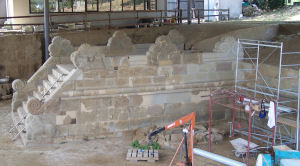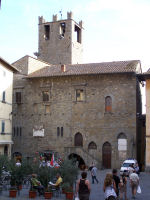Cortona rests on the southern spur of Monte S. Egidio (1057mt), one of the mountainous ranges which separates the Valdichiana from the Tiber Valley and which stretches from Arezzo as far asthe shores of Lake Trasimeno.
Cortona was once an important agricultural centre that was founded by the Umbrians and subsequently conquered by the Etruscans. Livy states that the Etruscans made Cortona into one of the most important "Lucumonie" (Etruscanleague cities) in Etruria togheter with Arezzo and Perugia.
The Etruscans left tombs and various other artifacts which have been found in the course of excavations giving evidence of their prolonged presence in these places.
In fact in the environs of Cortona there are tombs where they used to put the ashes or remains of the deceased, with rooms artificially covered with earth and large quantities of stones to make high mounds which the local people call "meloni" (melons).
 Melone II del Sodo |
The important families buried their dead under these handmade mounds (Extructi montes).
Having become a Roman Colony in 450 AD it appears that the ancient Greeks called Cortona, Crotone, while Publius Virgil Marone and Rutilius Namaziano refer to it as Corjtus.
It was then occupied by the Goths and after that there is no precise information about it until 1200 AD, when its rise as a Comune began. At this point Cortona was minting its own coin which circulated in Tuscany, Umbria and Some parts of the Marches from 1267 until the 16th Century.
During this period Cortona was divided by the Guelph and Ghibelline factions and had to sustain difficult struggles both internally and externally, especialluy with Perugia and Arezzo. In 1312, having become Ghibelline, Cortona welcomed Henry VII of Luxembourg, acknowledging him as Lord and Master of the city and its territory.
In the Middle Ages St. Francis chose Cortona to found a convent: The Monastery of the Cells which he entrusted to Brother Elia Coppi who became his successor in the administration of the Franciscan order. S. Margherita, famous for her charitable works following on her dramatic conversion, alsolived during this period.
 Palazzo Comunale |
As evidence of its growing importance Pope John XXII made it into a diocese in 1325 with Ranieri Umbertini as its Bishop. The rise of the Casali family also dates back to this period.
In the culturally vibrant climate of the Renaissance we come across the remarkable painter Fra Angelico, famous for the Annunciation.
In 1409 Cortona was conquered by Ladislaus, King of Naples who ceded it to the Florentines in1411 and thus the city first came under the rule of the Medici and then, from 1737, under theHouse of Lorraine.
Then, with the 1860 plebiscite it became part of the Kingdom of Italy.
The long history of Cortona boasts of many world famous artistic, literary and religious figures.
The 1600’s were distinguished by the painter and architect Pietro Berrettini (1596-1669) and the famous archaeologists and men of letters the brothers Venuti that founded the Etruscan Academy which is still very well-known both on a National and European level.
